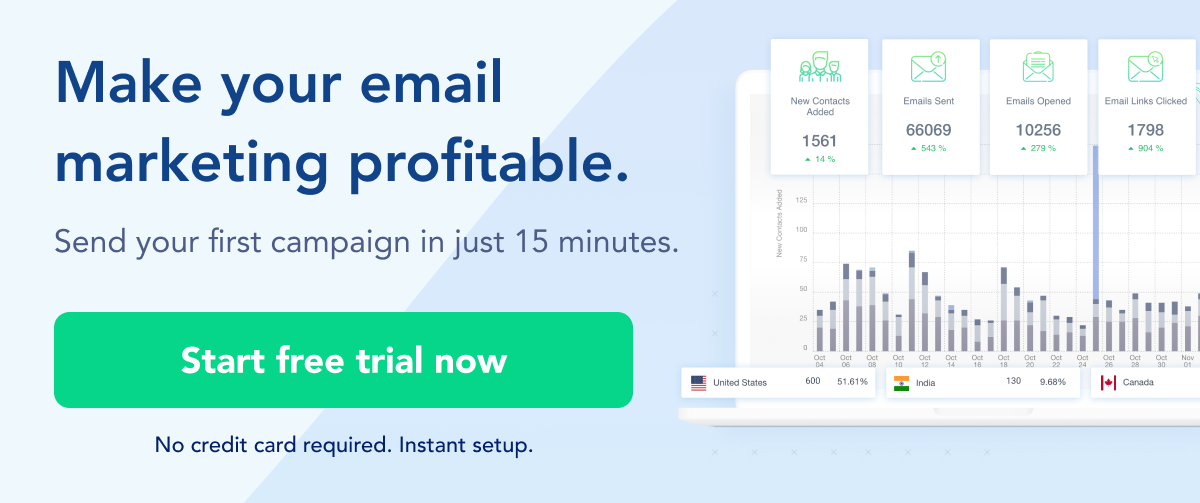
Vanity Vs. Actionable Email Marketing Metrics: How to Use Both
Data is a powerful ally when it comes to making strategic decisions. From knowing what type of email marketing content works well to planning campaigns to keep subscribers engaged at every step of the customer journey, metrics are the compass that guides you in the right direction.
However, not all metrics are created equal, and no single data point is a one-stop guide to making the best decisions (especially when not taken into context).
This brings us to email marketing vanity metrics: those pretty numbers that make your campaigns look good on paper but don’t contribute to your goals.
But how do you distinguish between fluff and actionable email marketing metrics that matter? Not to worry, this article will clarify the following.
Table of Contents
What Are Vanity Metrics?
In a nutshell, vanity metrics are those numbers that provide surface-level insight but don’t illustrate the bigger picture of what’s happening, nor positively contribute to your long-term strategic goals.
Relying on this data will not only inflate the overall picture of what’s happening but also has the potential to do more harm than good if not handled correctly.
Having a pretty report that doesn’t mean anything tangible doesn’t help anybody. Therefore, vanity metrics should be handled with great care and caution. You don’t want to use vague metrics that put you in a situation where you miss out on the opportunity to drive subscriber engagement, create content that’s driving clicks but virtually no conversions, or send correspondence blindly.
Email Marketing Vanity Metrics to Look Out For
Here’s a breakdown of vanity email marketing metrics to look at cautiously and why they’re problematic when considered in isolation. Open Rate=Total Number of Unique Email Opens(Total Number of Emails Sent - Total Number of Email Bounces)*100
Delivery Rate
It’s important to note whether your emails were successfully sent or not. A low delivery rate may be a sign to clean up your email list or authenticate your domain if it’s continuously ending up in spam folders.
That said, a high delivery rate doesn’t mean emails were even opened, much less engaged with. For example, you may have a 90% delivery rate, but it won’t mean much if only 1% of subscribers opened it (and even fewer would have meaningfully engaged at this point, which is what matters).
Delivery Rate=Total Number of Emails DeliveredTotal Number of Emails Sent Successfully*100
Open Rate
We understand that crafting a highly aesthetic and functional newsletter is a lot of work! And seeing a high open rate is exciting and feels validating to see.
But at the same time, a high open rate doesn’t mean that a viewer took the time to read your newsletter, nor does it translate to an action that affects your business's bottom line.
And that’s why open rate is a vanity metric when considered in isolation: it only shows how many people looked at your email when it appeared in their inboxes, but that doesn’t mean that it translated into something more meaningful.
Open rate is an excellent metric to use when testing subject lines and snippets, but a high open rate without any follow-throw does not drive the bottom line.
Open Rate=Total Number of Unique Email Opens(Total Number of Emails Sent - Total Number of Email Bounces)*100
Total Subscribers
Don’t get us wrong– a large emailable list rate is a promising sign that you’ll have an audience to reach out to. However, a high number of subscribers won’t mean much if users aren’t engaging with your brand or taking the action you want them to take.
Imagine having a large email database for your retail business but no one sweeping up your exclusive 50% Off coupon when it’s sent out. That shiny subscriber rate won’t mean much in those types of scenarios.
Total subscribers, especially if those subscribers are stagnant and unengaged, mean very little to a business.
Better metrics would include engaged subscribers (those who are opening and clicking emails), new subscribers (which shows that you are adding new leads into the mix, and list growth (an indication that new people are joining your email list faster than those who are unsubscribing).
Subscriber Growth Rate=Total Number of New Subscribers - (Total Number of Unsubscribes + Bounces)Total Number of Email Subscribers*100
What Are Actionable Metrics?
Conversely, actionable metrics are those critical data insights that tie into your KPIs, business objectives, and long-term goals.
Unlike vanity metrics, you’ll be able to make more sound and informed decisions because they are associated with clearly defined and measurable outcomes.
Actionable Email Marketing Metrics You Should Know
Wondering where to begin with actionable email marketing metrics? Here’s a good starting point to consider.
Conversions
Whether it’s following through on a call to action, sharing contact information, or even downloading an ebook, conversions are what you want to see and monitor.
Keep in mind that conversions don’t always equal sales. If the purpose of the email is to drive customers further down the funnel, if the email's recipient takes the next logical step in the conversion path (also known as micro-conversions), then that email should be considered a success.
This actionable metric shows user intent and is a good evaluator of email marketing performance. Viewing an email is one thing, but following through on a specific action means that you’ve done something right.
Conversion Rate=Number of Conversions Taken (e.g., clicking CTA)Total Number of Emails Successfully Delivered*100
Forward and Sharing Rate
Suppose a subscriber takes the initiative to forward your newsletter to someone else. In that case, it means something was interesting, noteworthy, or valuable in your email content (which is what you want to see). Engaged subscribers are great for business!
It also shows the potential of relevant email marketing to increase referrals and audience size.
Forward and Sharing Rate=Total Number of Shares and ForwardsTotal Number of Emails Successfully Delivered*100
Clickthrough Rate
After you’ve embedded those links and clickable images on your e-newsletter, it’s great to see they’re being followed through on (especially if your goal is to increase website traffic). Keep in mind that a clickthrough rate doesn’t always translate to a favorable action, such as filling out the contact form that a link leads to, or making an online purchase.
However, it’s a good indicator that your email marketing content was enticing or interesting enough to explore further.
Clickthrough Rate=Total Number of Unique ClicksTotal Number of Emails Successfully Delivered*100
Pro-Tip: Keeping track of email marketing metrics may be a handful, especially if you’re a growing business. Relying on automation and using an email marketing reporting tool to create marketing dashboards will increase efficiency and help you monitor trends over time.
Do Vanity Metrics Provide Any Useful Insights?
You may wonder why vanity metrics exist in the first place if they don’t provide a basis for strategic decision-making. To get some value from vanity metrics, you should:
1. Monitor Them For Useful Insights–But Don’t Mistake It For Solid Ground
A vanity metric might be a good data point to use if it supports the actual goal that you're trying to achieve.
For example, an uptick in the number of email subscribers may indicate that your content is engaging or that users are interested in learning more about your brand.
On the other hand, it won’t mean much if those subscribers aren’t your target audience or are spammy email addresses (which is where context comes into play).
2. Consider Vanity Metrics in Relation to Other Insights
Don’t look at one metric when making decisions. For example, look at the delivery rate in tandem with the open rate, click through rate, and conversions to understand how subscribers navigate your emails.
It’s one thing if emails were delivered, but you’ll need to know what happened after and how you can improve in the future (e.g., improving your newsletter design).
3. Use Them As Support for Actionable Email Marketing Metrics
Email vanity metrics are helpful when they help move the needle toward actionable metrics.
To achieve email marketing success, what’s typically considered a vanity metric may help you to put the puzzle pieces together.
Say you’ve participated in a retail trade show attended by people who fall within your target audience. After encouraging newsletter sign-ups at your booth, there’s a significant increase in subscriber rate and an uptick in online sales.
In this case, your growing subscriber base may indicate that this type of outbound event was worth your time, as it resulted in a high number of conversions. As you can see, contextualizing a vanity metric, in this case, helps you to make more informed decisions and reach your goals.
How To Decide On Actionable Email Marketing Metrics
It may be confusing to distinguish vanity metrics from insightful ones. Here are some tips to help you make that decision.
Evaluate Your Business Goals
Do you want to drive website traffic or boost online sales? Perhaps you want to increase the number of signups for the pre-launch of a product or service. Whatever the case, clearly understand what you want to achieve and how to steer your email marketing efforts.
Decide on Key Performance Indicators (KPIs)
Based on your goals you’ll be in a much better position to decide on KPIs based on your goals. For example, if your goal is to increase the number of online sales, perhaps your KPI should be “3000 online sales in Q2”. Tie in your long-term goals with numbers and regularly-spaced time intervals as much as possible.
Pro-Tip: When creating a KPI dashboard, use SMART (Specific, Measurable, Attainable, Realistic, and Timely) goals. That way, your KPIs won’t be up in the air or seem impossible to achieve.
Monitor Metrics That Contribute to Your Overall Goals
If an email marketing metric doesn’t affect your bottom line, it’s most likely not an actionable metric. After all, you don’t want to make strategic decisions based on surface-level insights that don’t contribute to the bigger picture in a solid way.
For example, looking at the email delivery rate in isolation isn’t a good measure of business success, especially if you’re focused on driving clickthrough rates or some other user action. Remember–not every metric is a KPI.
Wrap-Up
Email marketing is an efficient, wide-reaching way to keep your audience engaged, meet your goals, and build a solid brand reputation. The potential is limitless, but not without reliable data to back it up. Be wary of falling into the vanity metric trap: it only creates an ego boost and no accurate results when taken in isolation.
By understanding your audience, deciding on what’s most important to you, and tracking actionable email marketing metrics, you’ll be on your way to long-term success.



